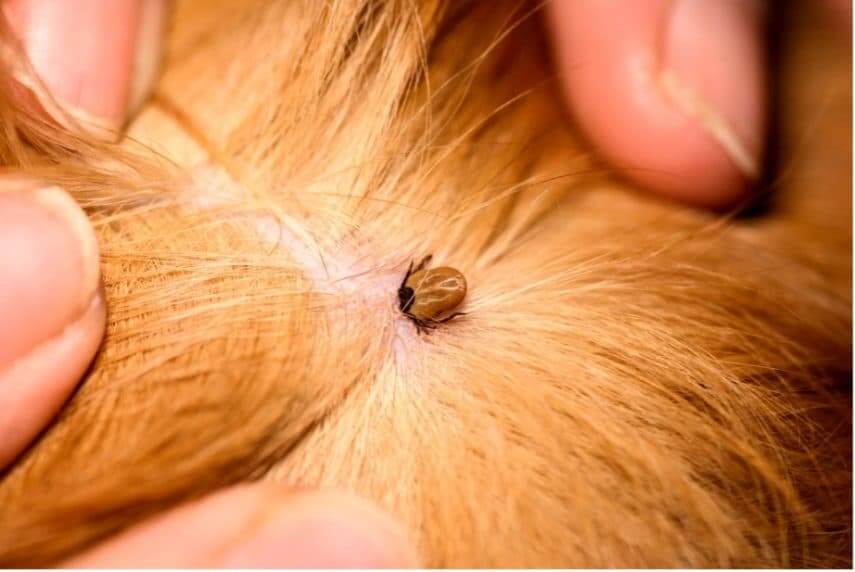Spring is in the air. But unfortunately, we also enter the flea and tick seasons here in Iowa. Even though fleas and ticks are here year-round, they thrive during warmer, moist weather. From April through July, we usually experience them the most. If you do not take preventative measures, they can cause health problems for your pets. It is good to know how to detect them, get rid of them, and most importantly, how to prevent them.
Fleas
If your pet gets fleas, you may notice them itching more frequently. Even though this is a sign of fleas, pets will also itch for many other reasons including allergies and skin infection. If the itching is caused by fleas, you may be able to see them crawling through your pet’s fur. Fleas are tall and thin and move very quickly through the fur. Because they are so fast, they may be difficult to spot and one of the easiest ways to detect fleas is by looking for “flea dirt”. This looks like tiny brown or black particles in your pet’s fur close to the skin and will often look like pepper. If you aren’t sure if it is dirt or flea dirt, the easiest way to tell the difference is by combing your pet with a flea comb and wiping the dirt onto a wet paper towel. If it is flea dirt, it will turn a brown or reddish color and will smear. This is flea feces or the digested blood of your pet that the fleas excrete.

Picture of flea dirt on a wet paper towel by Merck Animal Health
Fleas can quickly jump onto your pet from other animals such as squirrels, rats, opossums, etc. They can also jump onto your clothes and then jump onto your pets, putting indoor only, never leave the house pets at risk. A flea can jump as high as 7 inches and sideways up to 13 inches!
Fleas are not only a nuisance for your pet, they can cause skin irritation and allergies in pets. They can also transmit parasites such as tapeworms. Tapeworms can cause intestinal obstructions and can be fatal.
Ticks in Iowa
Ticks are eight-legged creatures, most closely related to spiders. They have highly developed mouth parts that can pierce the skin of your pet and feed on their blood. Ticks feed on blood to survive and produce eggs. An adult tick can start small (e.g., the size of an apple seed). But as they feed, they grow in size.

You will most commonly find ticks outdoors in leaf litter, shrubs, or bushes. Ticks also live in non-wooded areas and tall grasses. Ticks grab on to and cling on passing animals. For this reason, it is essential to check your pet for ticks after you’ve spent any time outdoors. If you feel a small bump on your pet, be sure to part your pet’s fur and take a closer look.
In Iowa, you can find more than a dozen species of ticks. The three most commonly encountered species are:
- Blacklegged tick (or deer tick) * the blacklegged tick is of the most importance to Iowans because it can transmit bacteria that cause Lyme disease. For more information on Lyme disease visit AVMA.org

- American dog tick or wood tick

- Lone star tick.

Images from TickCheck.com
Tick Bites in Pets
Following are symptoms of tick bites in pets:
- Fever
- Weakness
- Lethargy (not wanting to play like normal)
- Loss of appetite
- Shivering
- Unusual panting
- Paralysis
The most important thing is to contact your vet if your pet is experiencing any of the above symptoms.
How to Rid Your Pets of Fleas and Ticks
Fleas
It takes diligence and persistence to get rid of fleas. Here are steps you can take:
- Treat All Pets in the Home. Contact your veterinarian and find out the proper treatment for your pet. It is vital for your pet’s safety that you use the right one.
- Use a powerful vacuum. Vacuum your floors, upholstery, and mattresses. Cracks and other tight spaces are usually good hiding places for fleas and their eggs, larvae, and cocoons. If you can, use a vacuum with a bag you can dispose of without coming into contact with its contents.
- Use a steam cleaner for carpets and upholstery, including pet beds. The combination of high heat and soap is the enemy of fleas in all stages of life. Pay special attention to any hot spots where your pet usually lies down.
- Wash all bedding, including your pet’s, in hot water. Dry it at the highest heat setting. If the infestation is severe, consider getting rid of old bedding and starting anew.
- Use flea traps. Flea traps may not eliminate all fleas, but they can dramatically bring the numbers down in the home and make them more manageable. One brand is the Victor M230A Ultimate Flea.
- Treat the home. In a severe infestation, you may need to treat your home. Contact your vet for appropriate products and instructions to treat your home.
How to Remove Ticks from Pets
There are myths about how to remove ticks. Some include exposing it to heat, dousing the tick with peppermint oil, or twisting the tick to get it out. These are neither safe nor effective methods.
Watch this video from Pet MD on How to Remove a Tick Properly:

Flea and Tick Prevention
The best treatment for fleas and ticks is PREVENTATIVE treatment. Various brands of medicine cover both fleas and ticks.
We provide treatment and medications for flea and ticks. We tailor your pets flea and tick control recommendations to your pets lifestyle. If you have any questions or concerns regarding your pet, please contact us at Advanced Pet Care Clinic.
*Important note: make sure you get the proper treatment for your pet, especially for your pet’s weight. Using flea treatment meant for a dog on a cat or giving too high a dose to an animal can be fatal. Check with your veterinarian so you can be sure you are using the proper treatment.
Sincerely,
Dr. Tammy Stevenson

